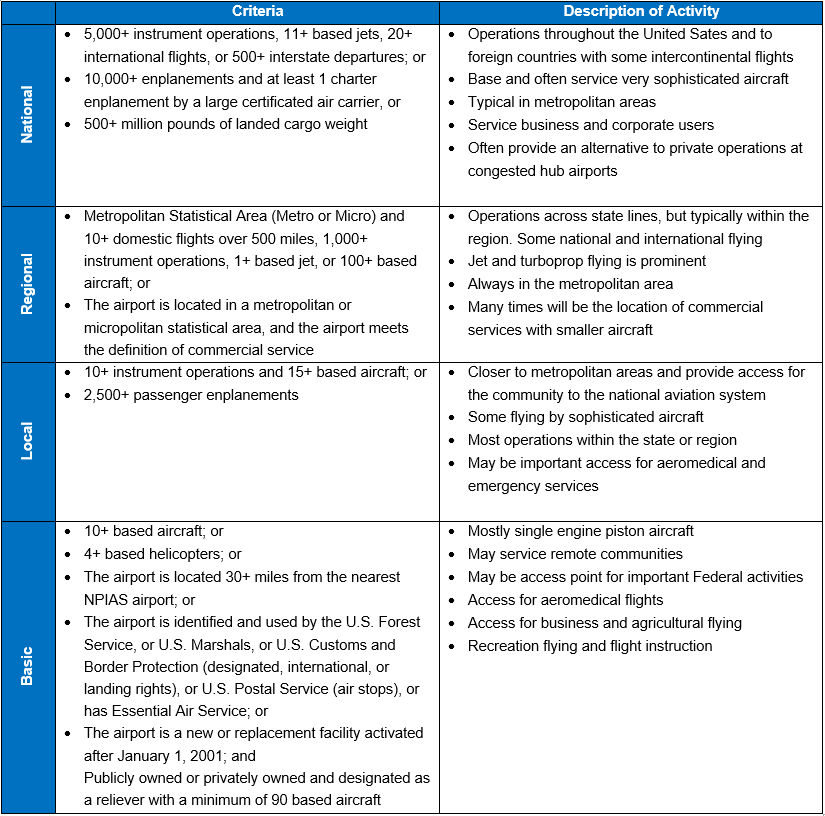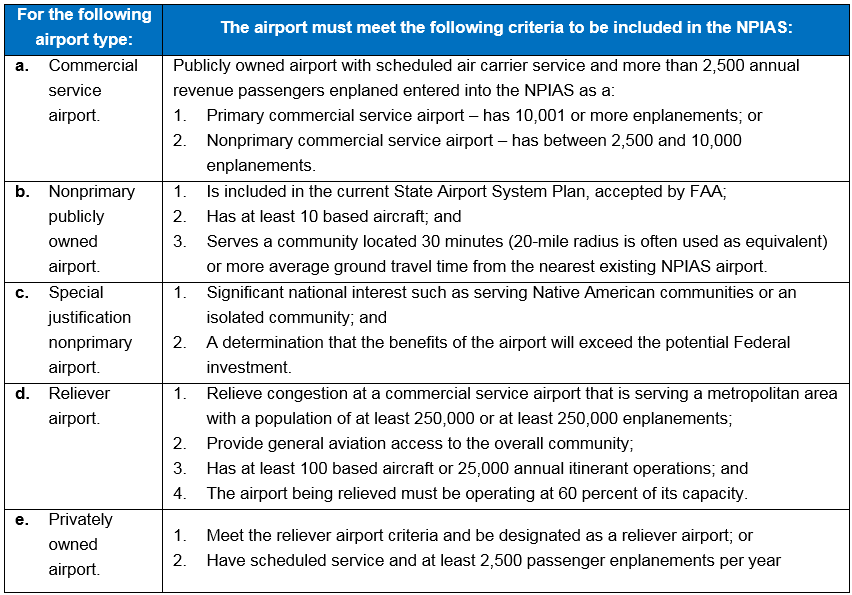Changing NPIAS Classification
Updates to the NPIAS occur every two years. As the roles of airports change, so can their NPIAS classifications. Airports and their communities can be aware and take an active role in understanding their NPIAS classification. According to the FAA’s 2015-2019 NPIAS report:
“The NPIAS report identifies for Congress and the public those airports included in the national airport system, the role they serve, and the amounts and types of airport development eligible for Federal funding under the AIP over the next 5 years.”
It is critical to communicate the importance of the NPIAS classification to the community and airport stakeholders. Use this information to tell the story of the airport: of how past, present, and future airport activity shapes the role of the airport. For example, a nonprimary reliever airport most likely would like to communicate about how the airport provides GA access to the community that would otherwise be difficult using only the region’s primary commercial service airport. Because inclusion in the NPIAS is directly tied to AIP funding and other airport services, the airport’s NPIAS role may be actively considered when investigating the potential role of the airport in the community. Additionally, the FAA makes available previous NPIAS reports on their website – use this information to learn how your airport has evolved and changed NPIAS classification over time.
This section outlines the details of how airports enter into the NPIAS and when classified in ASSET reports and what factors contribute to their classifications. Use this information to evaluate whether there have been any changes that could potentially reclassify the airport and what actions taken by the airport cause changes in classification. Be sure to explore your airport’s classification in the Identifying Your Airport’s Classification section.
Primary Airports
There are four categories of primary airports. The categories are based on the percentage of annual scheduled air service enplanements as compared to nationwide enplanements. Therefore, an airport must have commercial service to be considered a primary airport. To enter or exit this classification, or change hub size designation, an airport must have an increase or decrease in passenger enplanements. Airports that experience a start, modification, or end to commercial service are subject to changes in enplanements that subsequently might cause a change in primary airport status or hub size status.
Not all airports support commercial service. Market conditions or levels of airport certification and security can affect the ability of an airport to offer air service. It is important to keep in mind that your airport can serve many roles besides offering air service. To learn more about what affects enplanements, or how to begin air service, see the Air Service section of this report. Below are the four categories of primary airports and the criteria for each:
- Large Hub – These airports account for 1% or more of total U.S. passenger enplanements
- Medium Hub – Between 0.25% and 1% percent of total U.S. passenger enplanements.
- Small Hub – Between 0.05% and 0.25% of total U.S. passenger enplanements
- Nonhub – Airports with less than 0.05% of all commercial passenger enplanements but more than 10,000 annual enplanements are considered nonhub primary airports.
Nonprimary Airports
Nonprimary airports mostly serve GA activity. There are three service levels of nonprimary airports outlined below. Changes to commercial service, based aircraft or itinerant operations are examples of metrics that could affect an airport’s designation under this category. Keep in mind that nonprimary does not indicate low activity or use. Many nonprimary airports serve major roles in their communities and regions. The following are brief descriptions of the three service levels associated with nonprimary airports:
- Nonprimary Commercial Service – This type of airport has between 2,500 and 10,000 annual passenger enplanements, but a majority of its activity is GA.
- General Aviation Airports – Do not have commercial service but generally have at least 10 based aircraft and are more than 20 miles from the nearest NPIAS airport.
- Reliever Airports – These airports are high-capacity GA airports, commonly found near large metropolitan areas that must be open to the public, have more than 100 based aircraft, or have at least 25,000 annual itinerant operations.
ASSET
Remember, nonprimary airports are not only categorized in the NPIAS, but also through criteria developed in the ASSET 1 and ASSET 2 reports. Changes in activity levels could have an effect on the ASSET classification. Unlike primary airports, there are factors considered for ASSET classification that go beyond enplanements. Metrics such as cargo operations, instrument operations and number of based aircraft are used in ASSET classifications, and can be kept up to date so that your airport retains the proper designation. Some ASSET categories cannot be changed so easily. Location criteria such as distance from other NPIAS airports or proximity to or within a MSA will depend on factors the airport cannot control. To learn more about nonprimary airports and a breakdown of their roles, see the summary in the Understand topic section titled General Aviation Airports: A National Asset.
The following table describes activity levels of the four ASSET classifications and the criteria used to define each. Review this for clues on what your airport’s current role is and how it might change for the future.
ASSET Classifications and Criteria of General Aviation Airports

Source: FAA General Aviation Airports: A National Asset, 2012.
Airports Not Included in the NPIAS
A significant number of public-use airports are not included in the NPIAS because they do not meet the minimum entry criteria. Additionally, if your airport is privately owned and for private use only, then it would be automatically excluded from the NPIAS. Learn more about inclusion in the NPIAS through the Primary Airports and Nonprimary Airports topics presented in this section and the Airport Roles According to NPIAS section. Remember, airports included in the NPIAS must meet certain criteria to be included. According to Chapter 1 of the FAA Report to Congress Evaluating the Formulation of the NPIAS, there are four main considerations to be included in the NPIAS:
- Located at an adequate site and can be expanded or improved to provide a safe and efficient airport;
- Located more than 20 miles from another NPIAS airport; or
- The airport owner/operator has chosen NPIAS inclusion because they agree to be bound by the rules that accompany Federal funding.
- Meeting the minimum NPIAS entry criteria (outlined in the table below):

Source: FAA Report to Congress – Evaluating the Formulation of the National Plan of Integrated Airport Systems (NPIAS), November 2015
It is important to note that the number of based aircraft has an important role when it comes to NPIAS classifications. Therefore, it is critical to keep the number of based aircraft at your airport current using the National Based Aircraft Inventory Program website.